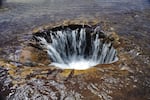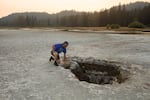Producer: Vince Patton Videographer/Editor: Michael Bendixen Animation: Todd Sonflieth, Oregon State Univeristy Additional Photos & Video: The Bend Bulletin-Ryan Brennecke, Brent McGregor, Vince Patton
The Oregon Cascades are full of holes from which water pours forth. We call them springs.
However, at
on Santiam Pass, three holes appear to work in reverse. They act like bathtub drains, sucking water down into a subterranean volcanic labyrinth.
The lake has suddenly become popular after a
went viral.
No one knew then there was more than one hole because water levels were still fairly high.
Terry McDermott stopped at the lake three times during trips over the pass, fascinated by the hole and the fast receding water.

Terry McDermott takes photos at the hole at Lost Lake.
Michael Bendixen / Oregon Public Broadcasting
She says, “At first the water was high and there was so much rushing over the edge you couldn’t see the bottom. I was afraid to get too close would I like would the rocks crumble and I’d fall in or something.“
On her third visit in a matter of weeks, Lost Lake’s waters had dropped and she could see the bottom for the first time just a couple of feet down.
“Oh! There’s snakes!”

A garter snake slithers in the hole in Lost Lake even as water pours in.
Michael Bendixen / Oregon Public Broadcasting
It turns out there’s a whole ecosystem down there, with at least two garter snakes and two adult toads.
“I guess the toads are too big for the snakes to eat,” says McDermott.
Terry Baker confirms that more people are stopping to see the Hole in the Lake. He’s also concerned that people might try to explore down inside it. He says the Forest Service does not know if the hole is stable. It could break through if someone stood in it.
“We definitely want people to be cautious,” says Baker.
So what’s really going on here?
Is this a portal into a larger lava tube just waiting to be explored?
Retired geologist Dave Kretzing doesn’t think so.
Kretzing says, “I can’t say for certain that that kind of plumbing doesn’t exist at depths but to me this actual orifice doesn’t look like the entrance to a lava tube.”
Kretzing is certain of one thing; there are still plenty of gaps in the layers of rock under our feet.

"Hole in the Lake" by Vince Patton and Michael Bendixen won one of OPB's five First Place awards in the 2016 SPJ NW Excellence in Journalism Contest
Courtesy Terry McDermott.
This entire region is the product of ancient volcanoes.
Eruptions happened over and over again in the last 12-thousand years.
“When you’ve got layers and layers of interbedded ash and glacial gravels and lava,” Kretzing says, “it forms a stack very much resembling sort of a geologic lasagna.”
Lost Lake’s 6-foot-wide drain feeds an underground river.
But Kretzing believes it’s flowing in extremely slow motion.
Scientists tracked radioisotopes in the water that showed it might take 3 to 7 years for water to travel from lost lake to Clear Lake.
It probably doesn’t end there.
Clear Lake feeds the McKenzie River but some of its water may go underground again down to Carmen Reservoir, and from they’re to Tamolitch Pool.
“There’s a lot going on here that most people don’t know about,” Kretzing says. “The lakes and the waterfalls here in the McKenzie River are just inextricably bound with the activities of the volcanic vents and the lava eruptions.”
Sometimes folks think that Lost Lake hole is a problem.
Dave says back when he worked for the US Forest Service, one of his colleagues found a man and his two grandsons shoveling silt into the hole in a feeble attempt to clog it up.
Kretzing says, “It wasn’t really the right thing to be doing, but it was cause their hearts were in the right place.”
Kretzing has heard rumors of a second hole but has never seen it.
We and several others came back in the fall of this big drought year and found not just one, but two more.

Brent McGregor peers into a second large hole in the bed of Lost Lake, revealed late in the season after waters receded.
Courtesy Brent McGregor.
Hole number two appears deeper and wider than the first.
About 15 yards away, Hole three may be little more than a small depression with grass growing inside.
Yet, it too appears to drain into the lava.
While Lost Lake hardly looks more like a dry meadow than a lake in the autumn, come spring, snow will melt, springs will refill it and the holes will be covered up with water.
For a while.
The cycle continues.
